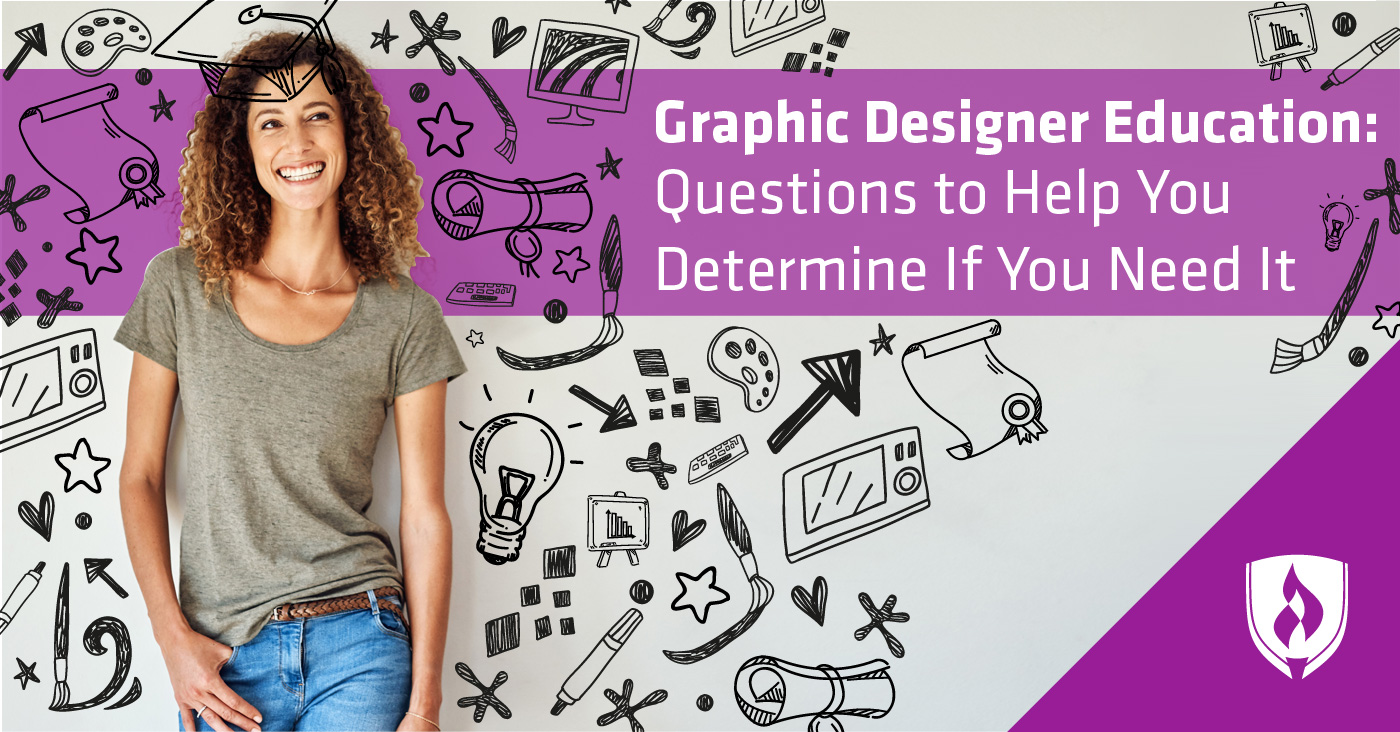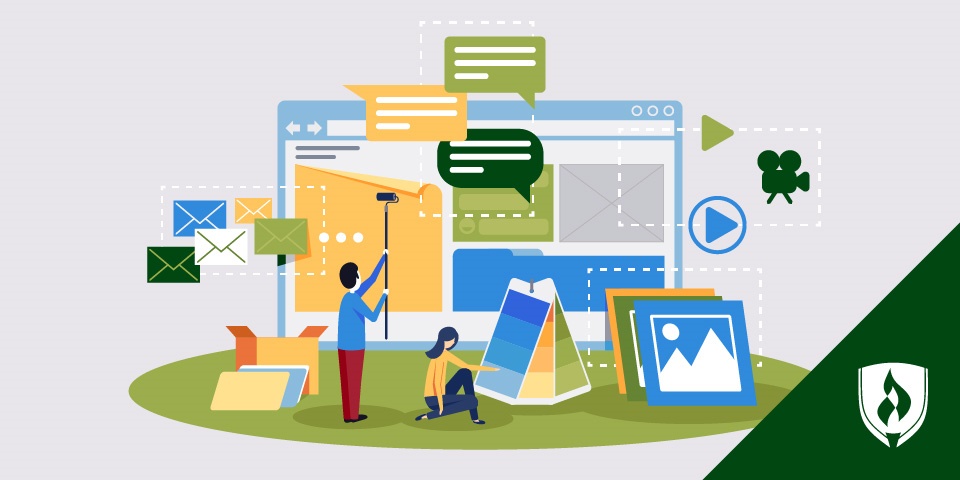Graphic Designer Education: 6 Questions to Help You Determine If You Need It
By Brianna Flavin on 07/24/2018

Creative careers like graphic design can be confusing when it comes to education requirements. If you were interested in medicine or engineering—sure, you’d expect to need a degree or two under your belt. But graphic design is truly an art. Does academic achievement really mean that much? You’ll often hear that the most important thing is your portfolio of prior work and previous experience, but so many job postings ask for a college degree.
So, what’s the deal? Does graphic designer education really matter if you can create beautiful work? Does structured training offer something you couldn’t learn on your own? Are there certain kinds of designers who don’t need a degree? While advancing your education has plenty of benefits, the truth is that the benefits of earning a Graphic Design degree may depend on your circumstances.
To help you sort this out, we’ve asked expert graphic designers (and the professionals who hire them) to weigh in.
6 Questions to help you determine if earning a Graphic Design degree is worth it
There are several important factors for designers to weigh when deciding their future educational plans. Ask yourself the following questions to help determine the importance of a degree for you.
1. How much experience do you have?
Some of our experts cited experience as the biggest substitute for a degree. If you have four or five years of professional design experience already behind you, the degree might not matter as much, according to Akiva Leyton, COO of Falcon Marketing.
This catch-22 happens in plenty of industries, but in design it’s particularly strong. You need jobs so you can build experience, but everyone seems to want experience before hiring you. “There is definitely that gray area in the industry, where you can get away with not having a degree, but only if you have tremendous skill and extensive experience,” Leyton says.
At the start, a degree in Graphic Design not only teaches you the skills and business abilities you’ll need for the career, but it also tells everyone else that you are up to those standards. When you are starting out with very little experience, a degree can help you get your foot in the door.
2. Do you hope to advance into higher positions?
“In my experience a college degree (or any kind of structured training) in Graphic Design is the necessary foundation of a successful career,” says Florian Heger, creative director and founder of Introbrand. “During [their education], students learn everything from design essentials to corporate branding and visual communication.
“I have more than ten graphic designers working under me and, in my experience, the very best graphic designers do have college degrees,” says Adam McIntyre, cofounder of BrandPacks. McIntyre says there are many self-taught graphic designers out there, but notes that degree holders tend to be the ones holding most advanced positions. If you have career plans that extend beyond entry-level design positions, then not having a degree can be an anchor holding you down. Like with your initial job search, this challenge can be overcome with the right portfolio, experience and circumstances—but it won’t be easy. While this may be frustrating, McIntyre believes there’s a good reason for the approach.
“In my opinion, this is because most self-taught designers simply learn to use graphic design software for achieving fashionable results, with little understanding of why,” McIntyre says. “College-educated designers, on the other hand, have a much deeper knowledge of the theories behind design and its trends.”
3. How do you feel about freelancing?
Freelancing, of all the graphic design career options, is often the most accessible route for self-taught designers. “In freelance design, your work speaks much louder than a resume,” says Erik Pitzer, graphic designer at Illumine8 Marketing & PR. “In some cases, companies hiring a freelance designer may never even see a resume.”
“Successful freelancing has many factors,” Heger says. A solid network, design experience and a portfolio displaying expertise in niche styles or areas of design can all make a big difference in finding work as a freelancer. If you are equipped with those things, then the degree might mean less for your situation.
But without those assets, freelance graphic designers might still want a degree to differentiate themselves and to help them understand the business sides of the work. “Even if some freelancer has a unique artistic talent in their niche, they would have a very hard time seeing the big picture of project planning, creation process and sales,” Heger says.
4. Do you want to influence your company’s design choices?
If you love design and have an artistic eye—it might drive you crazy to be relegated to simple task execution. “Unless you’re doing simple church newsletters or school posters, a degree is invaluable in understanding the wants and needs of your clients on a sophisticated level,” says Dave Poulos, director of marketing at Pinnacle Advisory Group. “You’ll want to be someone who brings ideas to the table, not just a vendor who does what he or she is told to do.”
This definitely applies to in-house and agency positions, but it also impacts your ability to freelance. Poulos says a degree in Graphic Design will give you a broader understanding in a variety of subjects to ask your clients the right questions and contribute to the conversation in a meaningful way.
5. Do you want to work in-house?
In-house graphic designers are hired by one company to consistently design for them over time and embody their brand. “Graphic design goes beyond logo design or a brochure design,” says Pablo Serrano, CMO and founder of BuyYourself. “We need people with an academic background because we need people who can argue, think critically and conduct research.”
In-house designers tend to have collaborative roles that might involve pitching ideas and assisting with visual strategy. “Most full-time, in-house graphic designers are expected to wear more than one hat,” Pitzer says. “Employers in those situations want to see a well-rounded education.”
6. How are your communication and negotiation skills?
“In addition to artistic and design skills, designers need to have excellent communication skills, both verbally and written,” says Kristen Romans, graphic designer at Mystic Aquarium. “College provides the opportunity to refine these skills beyond the basic fundamentals students learn in high school.”’
Highly professional communication and reliability is especially important in publication and marketing fields, according to Romans. Designers don’t only need the skill to communicate their own ideas, but also the ability to understand what clients are looking for, offering ideas that will communicate their brand. “A college degree, again, adds credibility and value to a designer’s ability to meet these requirements,” Romans says.
Is a Graphic Design degree your best option?
Now that you know a little more about when graphic designer education has the most impact, you probably have an idea whether it would be useful to you. But our experts insist that while a degree is almost always valuable, your portfolio is still most likely the deal breaker for clients and employers.
“Even with a college degree, a strong portfolio is a must,” McIntyre says. “Graphic design is a visual medium where pictures certainly speak louder than words—especially when you're trying to land a job.” Your work should always be a priority. McIntyre says you need a strong portfolio to present to employers and clients.
If you don’t have a portfolio that showcases your best, this is another area where a Graphic Design program could help you build that asset. But education in any format can be an investment, and you could use some more information to decide if it would really pay off. If you're interested in pursuing a career in animation, exploring reputable "Animation Courses" can provide you with the necessary skills and knowledge to thrive in this field.
For a more detailed look at what a Graphic Design education offers, check out our article, “Is a Graphic Design Degree Worth It or Worthless?”
Related Articles:




